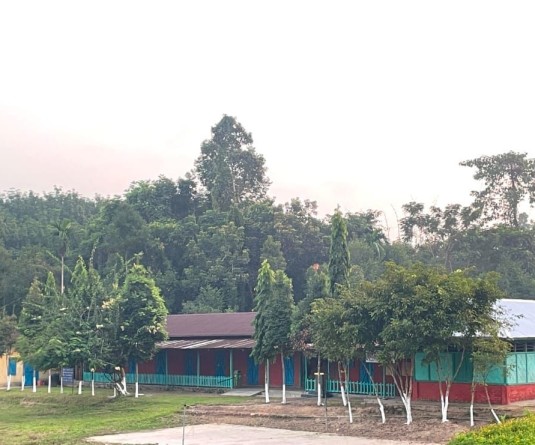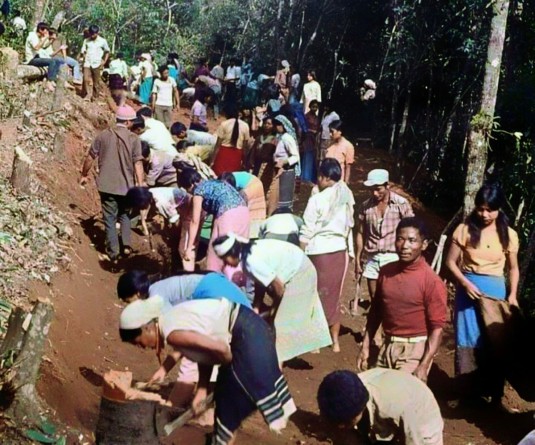(File Photo) A little boy scales a jump as he enters his hut at a village in Nagaland. A report of the Ministry of Housing & Urban Poverty Alleviation in 2011 points convincingly to a probable rendezvous with increased slum population in the coming 5 years. Although poverty line has rapidly decreased to almost negligible since 2005, the estimation for rural and urban slum populations in the state seems ready for an upsurge in the coming years. (Caisii Mao Photo)

Al Ngullie
Morung Express News
Nagaland government has a date with a colossal challenge during the next 5 years – a rapidly growing slum population in the urban areas (notably Kohima and Dimapur) although funding from the Central government, the Government of India, has been consistently substantial, central records show. 
The challenge appears even bigger, as understood from records which this daily obtained, about Nagaland’s financial performance in the development of urban infrastructure and basic amenities for the urban-poor population. For instance, points of doubt can be felt from the total central funds released and the actual results of their utilization in some major unemployment/urban poor and development/basic amenities thrust schemes currently in Nagaland. Some of these schemes, crying for harder, more proactive thrust in Nagaland are the Basic Services to Urban Poor (BSUP) and Integrated Housing and Slum Development Programme (IHSDP); the Swaran Jayanti Shahri Rozgar Yojna (SJSRY) – an employment scheme for the urban unemployed and underemployed poor).
The looming prospect of urban slums sprouting in the state’s urban areas (notably Dimapur and Kohima) is reflected in the ongoing thrust on the infrastructure service sector (sanitation, housing and standard of living, for instance).
A report of the Ministry of Housing & Urban Poverty Alleviation in 2011 points convincingly to Nagaland’s probable rendezvous with a slum headache in the coming 5 years. The cause of the projected increase in slum populations in Nagaland’s urban areas may be surmised from the dynamics of funds vis-à-vis fund utilization. Although the Central records show that the poverty line has rapidly decreased to almost negligible (from 36.92% in 1973-74 to a mere 3.3% since 2005), there are hiccups – big hiccups.
The hiccups are in the implementation of a number of urban-development and poverty alleviation developmental schemes. An instance is in the records from the report of the Ministry of Housing & Urban Poverty Alleviation listing the “targets and achievements” under the BSUP and IHSDP, both components of the Jawaharlal Nehru National Urban Renewal Mission (JNNURM).
During 2010-2011 the target for houses was 1,000 (under BSUP) and 500 (under IHSDP) totaling 1, 500 house units. The dwelling units completed was 720 (under BSUP) and 480 (under IHSDP) totaling 1,200 house units. Although the gaps seem comparatively insignificant – compared to overall outcome from the thrusts and the slum population – the difference are significantly disturbing on the final board.
The Central records also show the financial progress of Nagaland in both the schemes, Basic Services to Urban Poor, and Integrated Housing and Slum Development Programme, till August 2011. According to the records, the Additional Central Assistance released for BSUP was stated at Rs. 79.20 crore (Rs. 52.80 crore ACA utilized) and IHSDP at Rs. 29.92 crore, out of which Rs. 7.25 crore ACA was utilized. The total ACA utilized for both schemes was Rs. 60.05 crore only, out of the Rs. 109.12 crore ACA released to Nagaland.
Poverty down but Homeless up
Another interesting fact is that while the poverty index in Nagaland has decreased drastically since 1974 and an even sharper dip from 2005 onwards (to a mere 3.3% from 36.92% in 1973-74) the number of homeless in Nagaland stares out stark and loud – 63% (Rural homeless) and 37 % (Urban homeless), the records show.
And out of the index, 29% of the population lives without drainage while 19.5% of the state’s population has no direct opening/access to roads (percentage of households living in house with specific facility/specific conditions). These indicators from poverty, sanitation and housing indices show that the thrust of the funds and their implementation demands improvement in Nagaland.






